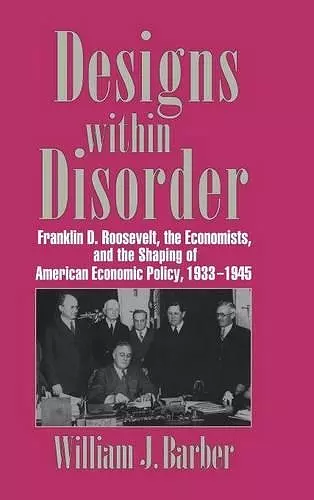Designs within Disorder
Franklin D. Roosevelt, the Economists, and the Shaping of American Economic Policy, 1933–1945
Format:Hardback
Publisher:Cambridge University Press
Published:28th Jun '96
Currently unavailable, and unfortunately no date known when it will be back
This hardback is available in another edition too:
- Paperback£37.99(9780521034319)

This 1996 book explains how economists helped to shape the American economy during the years of the New Deal and the Second World War.
Franklin D. Roosevelt drew heavily on the thinking of economists as he sought to combat the Great Depression, to mobilize the American economy for war, and to chart a new order for the post-war world. This 1996 book explains how divergent analytic perspectives competed for official favour and the manner in which Roosevelt opted to pick and choose among them when formulating economic policies.More than any of his predecessors in the White House, Franklin D. Roosevelt drew heavily on the thinking of economists as he sought to combat the Great Depression, to mobilize the American economy for war, and to chart a new order for the post-war world. Designs Within Disorder, published in 1996, is an inquiry into the way divergent analytic perspectives competed for official favour and the manner in which the President opted to pick and choose among them when formulating economic policies. During the Roosevelt years, two 'revolutions' were underway simultaneously. One of them involved a fundamental restructuring of the American economy and of the role government was to play in it. A second was an intellectual revolution which engaged economists in reconceptualizing the nature of their discipline. Most of the programmatic initiatives Roosevelt put in place displayed a remarkable staying power for over half a century.
'Barber has written a fascinating sequel to his From New Era to New Deal. Together, these books give us a superb - indeed, our very best - history of the role economists played in shaping federal policy between 1921 and 1945. Because he has done his homework in the archives, Barber is able to document the clash of competing ideas within the federal government, to demonstrate the linkages between ideas and policy, and to show us how the experiences of New Deal economists shaped the development of economic knowledge. In the process of explaining how Franklin Roosevelt organized the work of the economists, Barber favors us with a novel interpretation of Roosevelt - as 'an uncompromising champion of consumer sovereignty'.' W. Elliot Brownlee, University of California, Santa Barbara
'A society that grants enormous authority to economists in government had better pay attention to what and how they think. In this fine study, one of our leading historians of economic thought, William Barber, cuts to the core of the connection between economic knowledge and public policy during the New Deal. Barber shows how the dream of a full-fledged 'Fisc' to match the 'Fed' was blighted, and his emphasis on 'economic learning' - theoretical breakthroughs achieved experimentally, through the deliberative processes of governance - adds an important dimension to the typical new institutionalist preoccupation with structural constraints such as federalism. Barber;s shrewd observations about the not-so-positive implications for today of the low-savings, high-consumption lessons the Keynesians taught are thought-provoking. In all, this is an important book for all those interested in the critical debates that shaped the course of modern liberalism.' Mary O. Furner, University of California, Santa Barbara
ISBN: 9780521560788
Dimensions: 229mm x 152mm x 14mm
Weight: 450g
192 pages